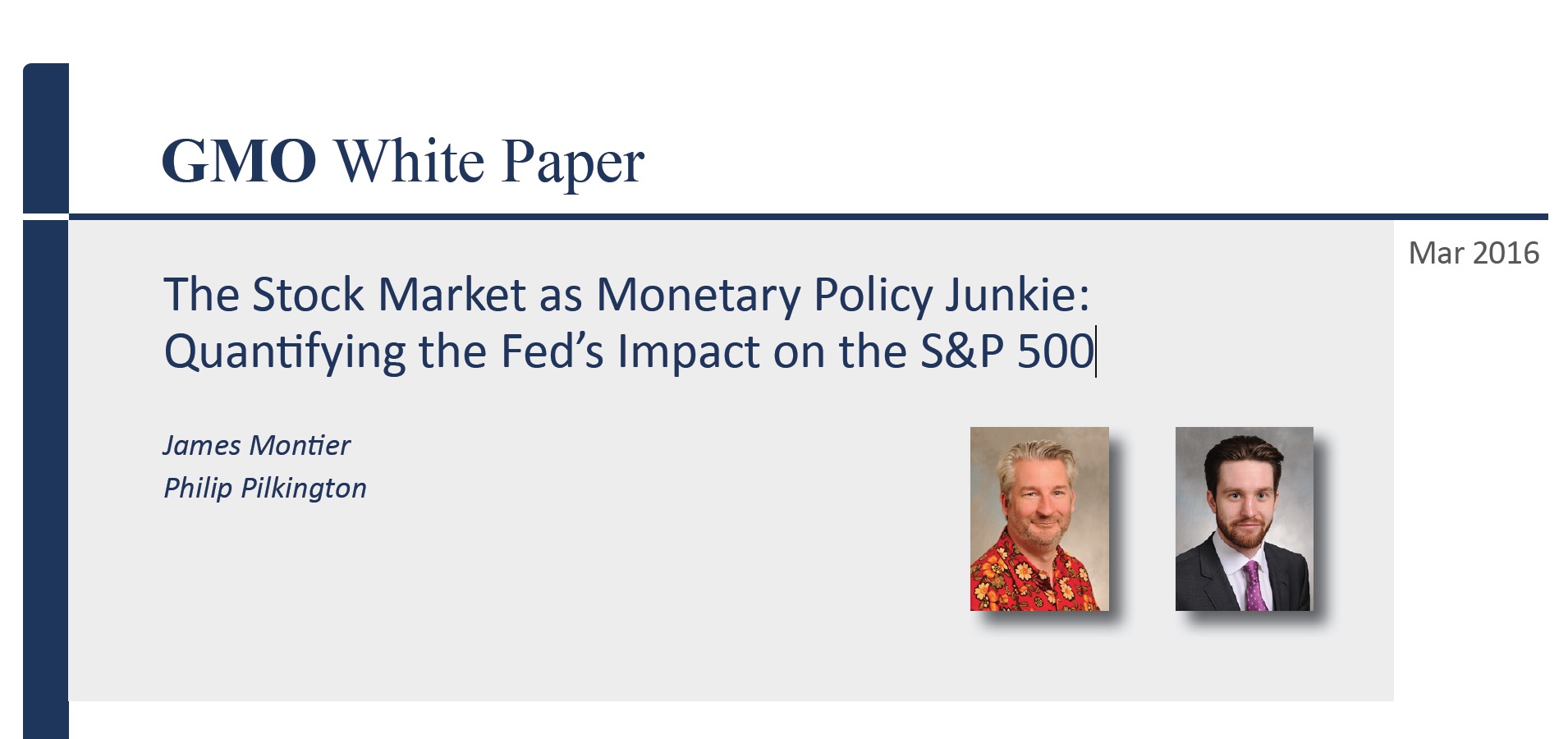The Stock Market as Monetary Policy Junkie:
Quantifying the Fed’s Impact on the S&P 500
by James Montier and Philip Pilkington, GMO
Executive Summary
One of the stated goals of the policies that the Fed has been pursuing since the Global Financial Crisis is to raise asset prices. In this short note we show that this has been standard operating procedure for the Fed since Greenspan’s tenure began. However, the transmission mechanism doesn’t appear to be lower rates, lowering the discount rate. Rather, it seems to come from the influence that the FOMC announcements have on market sentiment or “animal spirits.” We do find that Federal Reserve influence on the stock market has become particularly pronounced since the onset of its unconventional policies. We construct an alternative valuation measure (the Monetary Policy-Adjusted CAPE) that modifies Robert Shiller’s Cyclically-Adjusted P/E ratio (CAPE) in order to gauge the impact the Federal Reserve policies have been having on the S&P500.
Introduction
Jeremy Grantham has a lovely saying that resonates deeply with us, and it is, “Always cry over spilt milk.” Analyzing past errors and mistakes is crucial to improving our understanding, and vital if we are to stand any chance of avoiding making similar errors in the future. Indeed, “Always Cry Over Spilt Milk” was the title of an internal investment conference we held at GMO towards the end of last year. The deeper subject was seeking to understand why our forecast for the S&P 500 had been too pessimistic over the last two decades or so.
In August 2015, we shared some of the work that emerged from that event in the white paper, “The Idolatry of Interest Rates, Part II.” We would like to highlight two elements from that work that are of particular relevance for this note. First, we showed that our basic valuation framework has tended to underestimate the returns to the U.S. market of late because the market has simply turned out to be more expensive than we had expected (see Exhibit 1). Second, we showed that despite many protestations to the contrary, low interest rates didn’t really seem to be a viable explanation for the market’s high P/E.

This, of course, raises the question as to what might account for the higher P/E if it isn’t interest rates. At the end of one of our recent pieces1 we speculated that the Fed might well have a role to play in a broader sense than simply its interest rate decisions. We cited the late, great Nicholas Kaldor from a paper he wrote in 1958 arguing:
Reliance on monetary policy as an effective stabilising device would involve…a high degree of instability…in the capital market…The capital market would become far more speculative…longer run considerations of … profitability would play a subordinate role.
As Keynes said, when the capital investment of a country “becomes the by-product of the activities of a casino, the job is likely to be ill-done.”
Effectively, the Fed created enormous “moral hazard” and investors have been force-fed risk assets.
(Hence we have occasionally referred to this as a foie gras market.) Whilst this seemed preeminently plausible to us, we didn’t have any evidence to offer until recently. From the belly of the beast
In a delicious stroke of irony, the idea for our approach actually stemmed from research originating at the Fed! In 2013, two economists at the New York Federal Reserve published a paper entitled “The Pre- FOMC Announcement Drift.” In this paper the economists document “large average excess returns on U.S. equities in anticipation of monetary policy decisions made at scheduled meetings of the FOMC in the past few decades” (Lucca & Moench, 2013).
In a nutshell, the authors found that significant amounts of annual stock market returns over the past 30 years were made on FOMC meeting days. What is more, the authors found that “these pre-FOMC returns have increased over time and account for sizeable fractions of total annual realized stock returns.”
To continue, Read/Download the complete report below:
The Stock Market as Monetary Policy Junkie Quantifying the Fed's Impact on the s p 500
Copyright © GMO













